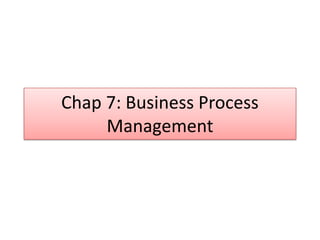
Chap 7: BPM and ERP Processes
- 1. Chap 7: Business Process Management
- 6. Problems with Functional Systems They tend to be isolated. Often referred to as “Islands of Automation” or “Information Silos” This is because they work in isolation from one another This type of system cannot not as productive and efficient as organizations would like them to be Why? Purchasing influences inventory, which influences production, which influences customer satisfaction, which influences, future sales…..
- 7. Cross-functional processes involve activities among several business departments. Example: customer relationship management (CRM) is a process that integrates activities of several departments, including sales, marketing, operations, accounting, and customer support. Cross-functional processes eliminate, or drastically reduce, problems of isolated systems and data. Example: Before an important sales call, salespeople can use a CRM system to learn if the customer has any outstanding issues or problems in customer support. Or, customer support can know which customers have high volume and justify high levels of support. Cross-Functional Processes
- 9. Problem resolution occurs via negotiation, contracts, and even litigation.Interorganizational Processes
- 10. Critical for a team to agree on both what is and what ought to be. Must have some notation for documenting processes and one common standard for creating process documentation. How Do Organizations Solve Process Problems?
- 12. Other business-modeling software products use other definitions and terms. These differences and inconsistencies can be problematic when two different organizations with two different sets of definitions must work together. How Do Organizations Solve Process Problems?
- 13. Object Management Group (OMG) created a standard set of terms and graphical notations for documenting business processes. That standard, called Business Process Modeling Notation (BPMN), is documented at How Do Organizations Solve Process Problems?
- 14. BPMN Process Diagram of Top-Level Business Processes at MRV
- 15. Software industry standardized notation for BPMN by Object Management Group (OMG) Business Process Modeling Notation (BPMN)
- 16. Figure 7.7 Task Assignments: Business Process with Three Swim Lanes
- 17. Adding a specialist to each activity in the process Three Ways of Changing Business Processes
- 18. Figure 7.10 Three Ways of Changing Business Processes Changing a process by altering process structure Changing a process by altering process structure
- 21. May be entirely manual, automated, or mixed information systems7-19
- 23. Integrates all primary activities of value chainSupports four phases of customer life cycle Marketing—marketing sends messages to target market Customer Acquisition—customer prospects order and need to be supported Relationship Management—support and resale processes increase value to existing customers Loss/churn—win-back processes categorize customers according to value and attempt to win back high-value customers Functions and Characteristics of CRM Information Systems CE12-20
- 24. CRM integrates primary value chain activities Scope of CRM in Value ChainActivities
- 25. Four Phases of the Customer Life Cycle
- 26. Figure CE12-4 Major Components of CRM Applications
- 27. CRM Centered on IntegratedCustomer Database
- 29. ERP Applications and the Value Chain
- 30. Primary ERP users are manufacturing companies. First and most successful vendor of ERP software is SAP. More than 12 million people used SAP in over 91,000 SAP installations. Worldwide, SAP has over 47,000 different customers (2008). Oracle is a second major ERP vendor. ERP vendors provide software and predesigned databases, predefined procedures, and job descriptions for organization-wide process integration. Beware: Some vendors misapply the term ERP to their systems. There is no truth-in-ERP-advertising group to ensure that all of the vendors that claim ERP capability have anything remotely close to it. ERP Facts
- 31. Entire organization is a collection of interrelated activities and cross-functional processes Formal approach based on documented, tested business models Process blueprint documents each process with diagrams using standard symbols Centralized database Can be slow to implement Very costly—new hardware and software, developing new procedures, training employees, converting data, and other developmental expenses ERP Characteristics
- 33. Example of SAP OrderingProcess
- 34. Efficient business processes that are effective Inventory reduction Lead-time reduction Improved customer service Greater real-time insight into organization Higher profitability No data inconsistency problems due to integrated database Business process blueprints tested in hundreds of organizations Benefits of ERP CE12-31
- 35. Model current business processes “as is” Identify relevant ERP blueprint processes Compare as-is process models with relevant blueprints and note differences Find ways to eliminate differences Prepare detailed plan Train users on new processes, procedures, use of ERP features and functions Conduct simulation to test new system Convert data, procedures, personnel to new system Follow phased system conversion approach How Is an ERP System Implemented?